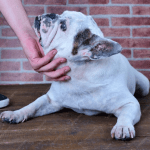English bulldogs are one of the most popular dog breeds in the world, known for their wrinkled faces and charming personalities. However, breeding these beloved pups isn’t as simple as finding two dogs and letting nature take its course. There are several factors to consider, including age and health risks. We’ll explore how old an English bulldog needs to be before it can breed safely, as well as some important considerations for anyone considering producing these lovable pups. So please grab a cup of coffee, and let’s dive in.

The History Of Bulldog Breeding
The Bulldogs have a fascinating history that dates back centuries. Initially bred for bull-baiting, these dogs were used to pin down and subdue bulls until the 1800s, when the practice became illegal in England. Bulldogs then transitioned into companion dogs and show dogs.
In the early 1900s, bulldog breeding became popular in America, with breeders working to create a more distinctive look for the English bulldog. However, this selective breeding has caused health problems over time due to physical traits like their short snouts.
Despite their tumultuous past, English bulldogs remain one of the most beloved dog breeds today because of their loyalty and affectionate nature towards humans. Potential breeders must consider historical context and modern-day ethical considerations before deciding whether or not to breed these pups.
The Health Risks Of Breeding Bulldogs
Breeding English Bulldogs is not an easy task and comes with its own set of health risks. These dogs are prone to various health issues, many of which can be passed on to their offspring. Hence, ensuring the breeding process is done responsibly is crucial.
One major problem associated with bulldog breeding is Brachycephalic Syndrome. Bulldogs have a short snout, which makes breathing difficult for them and thus leads to respiratory problems in both parents and puppies.
Eye problems are also common in bulldogs due to their flat face structure, leading to irritation or infection. Bulldog breeders should take care when selecting mates that do not have this issue or only carry the gene mildly.
Skin problems such as allergies and irritations can occur in bulldogs due to their skin folds, where bacteria and fungi thrive easily. The same goes for ear infections, which may require frequent cleaning by owners who want healthy puppies.
Orthopedic diseases like hip dysplasia are often seen in larger dogs. They also present a risk factor for breeding English Bulldogs since they make it challenging for them during pregnancy or delivery stages.
Cancer incidence rates tend to increase when breeds come from small, shallow genetic pools, making careful selection paramount before any reproduction decisions are made.
Caesarian section deliveries happen frequently among Bulldog breeds because most females cannot give birth naturally; hence, breeders must prepare well ahead of time financially, too, since vet bills will rise exponentially if complications arise during the birthing process.
Brachycephalic Syndrome

Brachycephalic syndrome is a condition commonly found in English bulldogs. This syndrome is caused by the shape of the head, which leads to breathing difficulties that can be fatal if left untreated.
Dogs with brachycephalic syndrome have narrower airways than other dogs, making it harder for them to breathe. Symptoms include difficulty breathing, snoring, and coughing. They may also become quickly tired during exercise or playtime.
The most common cause of Brachycephalic Syndrome in English Bulldogs is an elongated soft palate that blocks the airflow into their lungs. Other causes may include enlarged tonsils or a narrow trachea.
While there are treatments available for this condition, prevention is critical. Breeding should only occur between dogs without signs of this syndrome to prevent passing on these genetic traits to offspring.
If you’re considering breeding English Bulldogs, it’s essential to understand the health risks associated with this breed and take the necessary precautions.
Eye Problems
Bulldogs are known for their prominent and adorable eyes, but unfortunately, they can also be prone to various eye problems. One common issue is cherry eye, which occurs when the dog’s third eyelid gland inflames or protrudes.
Other potential eye problems include entropion, where the eyelids roll inward, causing irritation and discomfort to the eyeball. Additionally, Bulldogs may suffer from ectropion, which causes sagging lower lids that expose too much of their eyes, leading to dryness and infections.
Bulldogs can also develop cataracts early, resulting in cloudy areas on their lenses that limit vision. Glaucoma is another severe condition of Bulldogs; it happens due to increased pressure within your dog’s eye, which leads to severe pain and loss of sight if not treated immediately.
Regular veterinary checkups can help identify these issues before they become more severe. It is essential to keep a close watch on any changes in your Bulldog’s eyesight or behavior that indicate possible problems so you can seek medical attention promptly.
Skin Problems
Skin problems are a common issue with English Bulldogs. They can suffer from allergies, infections, and other skin conditions. Various factors, such as food allergies, environmental allergens like pollen or dust mites, or parasites like fleas and ticks, can cause these skin issues.
One of the bulldogs’ most common skin problems is Demodectic mange, caused by mites on the dog’s hair follicles. Symptoms include bald spots, redness, itching, scabs, and sores.
Bulldogs are also prone to developing hotspots and painful and itchy patches caused by bacterial infections that develop when a dog licks or chews an area excessively due to allergies.
It’s essential to watch for any changes in your Bulldog’s skin health. If you suspect something may be wrong, it is best to take them to your veterinarian, who will diagnose any underlying issues before they worsen.
Orthopedic Diseases

One of the biggest concerns for English Bulldog breeding is orthopedic disease. These conditions affect the bones, joints, and muscles of these dogs.
Orthopedic diseases can be hereditary or acquired through injury or overuse. Some common orthopedic problems in English Bulldogs include hip dysplasia, elbow dysplasia, patella luxation, and osteochondritis dissecans (OCD).
Hip dysplasia occurs when the hip joint doesn’t fit properly into its socket, leading to pain and difficulty walking. Elbow dysplasia is a similar condition affecting the dog’s front legs.
Patella luxation happens when the kneecap slips out of place, causing pain and lameness. OCD occurs when pieces of cartilage break off from a joint surface, which can lead to arthritis if left untreated.
It’s important to note that while not all cases of orthopedic disease are preventable, responsible breeding practices can help reduce their likelihood in future generations of English Bulldogs.
Cancer
Cancer is a severe and often fatal health risk for English Bulldogs who are bred too young. Many bulldogs bred before their bodies mature will develop cancer later in life. This is because breeding can cause stress on the body, which weakens the immune system and makes it more susceptible to disease.
There are many different types of cancer that an English Bulldog can develop, including lymphoma, bone cancer, and mammary gland tumors. Unfortunately, many of these cancers are not curable once created.
To reduce the risk of cancer in your English Bulldog, it’s essential to wait until they’re fully mature before considering breeding them. Additionally, it would help if you always worked with a reputable breeder who prioritizes the health and well-being of their dogs over profit.
If you suspect that your English Bulldog may be developing signs or symptoms of cancer (such as unexplained weight loss, lethargy, or difficulty breathing), consult with a veterinarian immediately. Early diagnosis and treatment can significantly improve your dog’s chances of survival.
Caesarian Sections
While breeding English Bulldogs may seem like a simple process, it is clear that several risks are involved that cannot be ignored. The health of the mother and puppies must always come first, and responsible breeders should carefully consider all possible outcomes before deciding to breed their dogs.
One issue that can arise during Bulldog pregnancies is difficulty in natural delivery due to large head sizes or other complications. This often necessitates a Caesarian section for the safe delivery of the puppies. While this surgery is joint, it poses additional risks for both the mother and the pups.
Breeding English Bulldogs comes with many challenges and potential health risks. Breeders need to prioritize the well-being of their dogs over profit or personal gain. By understanding these issues and taking appropriate measures to prevent them, we can ensure healthier lives for future generations of English Bulldogs.


